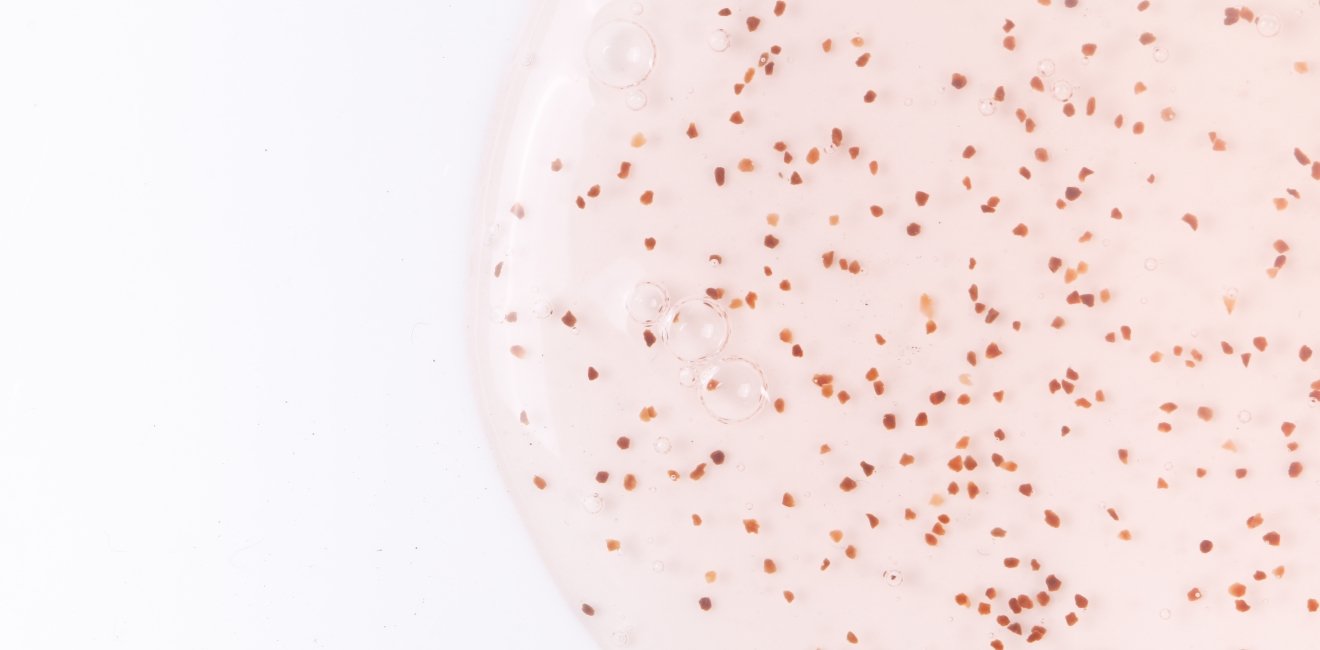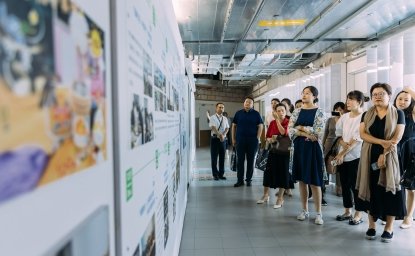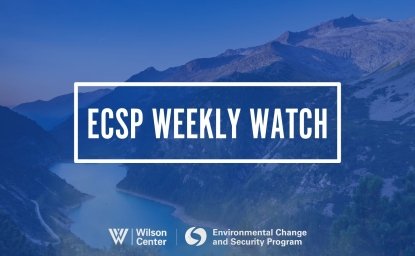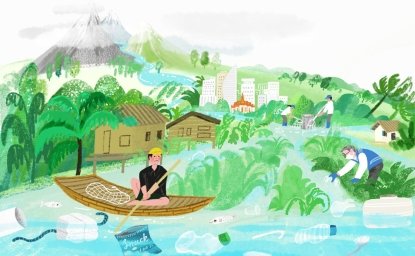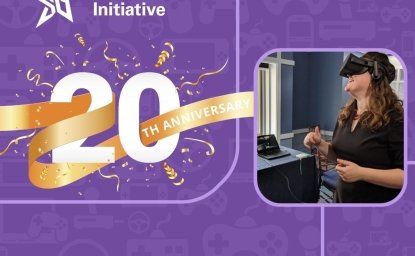Background
Plastics, ranging from the circles of soda can rings to microbeads the size of pinheads, are starting to replace images of sewage for a leading cause of pollution – especially in the ocean [1]. The threats of plastics are pervasive, with current estimates placing over 250,000 tons of plastic floating around the world’s oceans [3].
In the spectrum of ocean polluters, microplastics are a significant offender. Microplastics are formed by the degradation of larger plastics and fibers, or from the production and waste associated with microbeads. According to the participants in the International Research Workshop on the Occurrence, Effects, and Fate of Microplastic Marine Debris, microplastics are classified as fragments of plastic less than 5 millimeters long [2]. The strength and danger of these small pollutants are derived from their seemingly innocuous size (see Figure 1). Because of their minute size, microplastics can be ingested by a variety of organisms from zooplankton to seabirds [6]. Further, even though some microplastics may be too big to pass through cell membranes of plants and animals, there is growing concern that the toxic chemicals they harbor, like organochlorine pesticides (think DDT) may spread throughout marine organisms upon ingestion [5].

Figure 1 Microplastics, like the ones presented above, are commonly found in ocean samples. Microplastics can come in many forms from beads and shards to microfibers. Image by 5Gyres, courtesy of Oregon State University.
Microplastic consumption impacts every rung of the food chain, a food chain in which we sit atop of, making plastic and microplastic pollution a threat to both environmental and, potentially, human health. Reports from NPR’s food news division The Salt detailed the emerging knowledge of the presence of microplastics in most food obtained from the ocean’s waters [7, 8]. Research still primarily covers the “potential” health impacts of microplastics rather than any that are “observed” [9, 10], underpinning a gap on the effects that microplastics may or may not have on human development, the immune system, and many other potential health concerns. While that line of research is ongoing, scientists and policymakers believe that it is better to be proactive than reactive in dealing with this increasingly pervasive problem. Austin Baldwin of the US Geological Survey (USGS) was quoted by PBS saying, “Even if we decide it’s not a big problem right now, maybe 20 years from now it will be a problem [11].”
One innovative solution may be found in citizen science, a process where members of the public voluntarily contribute to scientific research to meet real world goals. Citizen science is a unique opportunity for raising awareness about the problem, educating the public about potential mitigation strategies, and providing enough scientific data to help researchers understand the full extent and consequences of plastic and microplastic pollution.
Partial Solutions
Microplastics manufactured as microbeads and microfibers, from degraded textiles, are a problem tied to production and consumption. Luckily many mitigation efforts are underway by manufacturers or consumers. Green companies like Patagonia have made changes in their products in order to lessen their impact on microplastic proliferation [12]. Such strategies range from improving the quality of their apparel to reduce microfiber degradation, which may occur during washing cycles, to general plastic waste awareness campaigns. Organizations like the Plastic Pollution Coalition and the Oceanic Society also provide the public with lists of microplastic usage-reducing behavior like using a cold water wash spin or doing full loads of laundry to curb the deterioration of clothes and release of microfibers [13, 14].
In parallel, the research community is exploring the causes, occurrences, effects, and future consequences of continued microplastic pollution. Like many research problems that require spatially and temporally diverse data, professionals are increasingly leveraging citizen science [15]. These citizen science volunteers can collect data en masse, and also in hard-to-reach areas such as remote environments or private lands. Involving members of the public in citizen science has been found to increase public understanding and awareness of a scientific issue [16] and empower volunteers to participate in policy and decision-making cycles [17].
The Citizen Science Solution
With recent backing from the Crowdsourcing and Citizen Science Act, citizen science is increasingly embraced as a tool by US Federal agencies [18]. Two NOAA programs collaborated to begin the Florida Microplastic Awareness Project in September of 2015. Funding was provided by a NOAA Marine Debris Program Marine Debris Prevention through Education and Outreach Grant to Florida Sea Grant, to “study microplastics and lead education and outreach events [19].” The project was both educational—it made Floridians more conscious of their plastic consumption—and useful to quantitatively collect microplastic data from coastal sites around the perimeter of Florida. By using the pre-established network of partners of the Florida Sea Grant, regional coordinators were contacted and trained in microplastic education and sampling [19].
These coordinators were then able to provide educational information and sampling protocols to citizen volunteers through a rigorous training program. Volunteers sampling Florida’s cost collected microplastics data that is aggregated and analyzed on a publically accessible map hosted by the University of Florida [20, 21]. Leveraging environmental events such as Earth Day and the International Coastal Cleanup, the program encourages individuals to pledge to reduce the amount of plastic waste they generate by taking specific actions [19]. To help measure impacts of this program, researchers conduct follow-up surveys to assess the adoption of these behaviors. While these results are subject to biases associated with self-report, in general Florida’s citizens meet the program with enthusiasm and commitment [22]. A second NOAA project, the Marine Debris Tracker app, also helps members of the public curb microplastic pollution by allowing citizens to report coastal debris and litter through an app on their phone [23].
Another government sponsored practice that leverages citizen science practices to combat microplastics is found at the US EPA. In 2016, the EPA hosted an event at the College of Environmental Science and Forestry (SUNY- ESF) on Detecting Microplastics in Waterways with Citizen Science [24]. Participants were treated to lectures on the current state of microplastics and information on where the public could get involved to provide data collecting support to ongoing projects. The keynote speech given by Dr. Marcus Eriksen, co-founder of 5 Gyres Institute, focused on the hazards of plastics in the ocean and the activism surrounding this issue. 5 Gyres has two main methods of collecting the microplastic data through citizen science. In their Trawl Share program, Trawls are used to skim the surface of the water and collect plastics as well as other debris. Citizen scientists with access to aquatic vehicles can rent a trawl, collect data around their location, and send the results to 5 Gyres for further analysis and compilation into a world database [25].
5 Gyres also provides an annual Adventure program that provides expeditioners an opportunity to travel the world while also collecting microplastic concentration data. In 2018, volunteers will embark on an Expedition through Indonesia’s Coral Triangle from Bali to Komodo to sample microplastics and explore solutions to the problem of plastic pollution [26]. Similar programs are also run by Adventure Scientists, an organization that connects members of the outdoor adventure community with scientific partners in need of remote data collection and analysis.
While Adventure Scientists promotes a number of environmental research projects, their Global Microplastics Initiative is one of their most expansive [27]. Similar to 5 Gyres, Adventure Scientists has co-sponsored ocean expeditions in conjunction with organizations like Polar Latitudes which leads adventurers on Antarctic expeditions. To date, the Polar Latitudes team has collected 12 remote Antarctic samples (9 of which containing microplastics), contributing to research on microplastics distribution [28]. Other data sources range from the state of Maine to the country of Thailand, resulting in a searchable map (figure 2) depicting “one of the largest and most diverse global microplastic pollution datasets to date [27].”

Figure 2 Adventure Scientist’s updated map of global microplastic collection data [27].
The efforts of Adventure Scientists have been leveraged by initiatives like National Geographic’s “Pristine Seas” program by providing data and assistance for environmental policy recommendations to foreign governments [29]. Private sector decision-makers are also engaged: the popular accessory brand Croakies also took notice of Adventure Scientist research and have changed their manufacturing process in order to promote better more environmentally-conscious practices [30, 31]. While researchers have used Adventure Scientists data in at least three peer-reviewed publications, the data is also available upon request to benefit a wide range of stakeholders.
The Possibilities Ahead
International efforts engage citizen science volunteers from countries including Chile and Japan [32, 33, 34]. While many studies are mostly geared towards education and cleanups rather than data collection, the bottom-up logic of stopping plastic from getting into the water is a great first step in quelling microplastic pollution. Further, building awareness through education may be an important step towards engaging citizens in plastics research activities, encouraging conscientious consumer behavior, or even inspiring volunteers to contact a local government official to express their concerns. As microplastics increasingly become a buzz-worthy topic, even more citizen science projects are likely to emerge. One strength of citizen science is the ability to tailor projects to the skills and concerns of unique populations. Members of the extreme adventure community traveling to Antarctica with Adventure Scientists, for example, are likely to have different perspectives on environmental pollution and conservation than school groups combing beaches in Chile. Looking towards the future, it’s vital to not only encourage initiatives that engage a particular type of volunteer, but also to coordinate between projects seeking to collect and share data to the greatest extent possible. Microplastics are a global problem that require global-scale data, analysis, and global solutions. An international database of information on microplastics would benefit the general public, the research community, manufacturers, and policymakers seeking to work together to understand and combat this type of pollution.
One opportunity for coordination may be found within and between US government agencies. For example, the citizen science initiatives encouraged in 2016 by EPA’s Region 2 could be expanded, and also encouraged in other EPA regions to create an agency-wide citizen science microplastics initiative [35]. A June 2017 Microplastics Expert Workshop has already explored the future of microplastics research at EPA. As one outcome, EPA encourages further investigation and innovation that, with sufficient public interest, could be geared towards citizen science.
Despite the widespread uptake of citizen science in US federal agencies there is no coordinated, large-scale initiative that leverages the unique missions of each Agency to engage the public in research on a certain topic. The issue of microplastics pollution lies at the nexus of research interest, public engagement, and necessary government action. Further, unlike pervasive pollutants such as mercury or carbon dioxide, plastics and microplastics are identifiable by the naked human eye. This visibility offers a powerful opportunity for engagement if volunteers can identify, and seek to understand, the extent and impact of plastics and microplastics on the surrounding environment. Data from NOAA initiatives like the Marine Debris Tracker program could be combined with future work supported by agencies like EPA, as well as the efforts supported by NGOs and private sector partners, to create a new global platform promoting research, education, and action around microplastics. Such an initiative could also serve as a model for large-scale environmental research and governance projects that leverage the skills and needs of diverse stakeholders including the general public to tackle complex and pervasive modern day challenges.
References
- Andrady, Anthony L. (2011). Microplastics in the Marine Environment. Marine Pollution Bulletin, 62(8): 1596-1605.
- Arthur, Courtney, Joel Baker and Holly Bamford (eds). (2009). International Research Workshop on the Occurrence, Effects and Fate of Microplastic Marine Debris, Conference Proceedings. Sept 9-11, 2008. NOAA Technical Memorandum NOS-OR&R-30.
- Eriksen, Marcus, Laurent C.M. Lebreton, Henry S. Carson, Martin Thiel, Charles J. Moore, Jose C. Borerro, Francois Galgani, Peter G. Ryan, and Julia Reisser. (2014). Plastic Pollution in the World’s Oceans: More than 5 Trillion Plastic Pieces Weighing Over 250,000 Tons Afloat at Sea. PLOS One.
- Dris, Rachid, Johnny Gasperi, Cecile Mirande, Corinne Mandin, Mohamed Guerrouache, Valerie Langloi, and Bruno Tassin. (2017). A first overview of textile fibers, including microplastics, in indoor and outdoor environments. Environmental Pollution, 221: 453-458.
- Teuten, E.L., Saquing, J.M., Knappe, D.R.U., Barlaz, M.A., Jonsson, S., Bjorn, A., Rowland, S.J., Thompson, R.C., Galloway, T.S., Yamashita, R., Ochi, D., Watanuki, Y., Moore, C., Viet, P.H., Tana, T.S., Prudente, M., Boonyatumanond, R., Zakaria, M.P., Akkhavong, K., Ogata, Y., Hirai, H., Iwasa, S., Mizukawa, K., Hagino, Y., Imamura, A., Saha, M., Takada, H. (2009). Transport and release of chemicals from plastics to the environment and to wildlife. Philos. Trans. R. Soc. B 364, 2027–2045.
- Lin, V.S. (2016). Research highlights: impacts of microplastics on plankton. Environ Sci Process Impacts, 18(2): 160-163.
- Ken Christensen, “Guess What’s Showing Up In Our Shellfish? One Word: Plastics,” NPR, September 19, 2017.
- Jessica Boddy, “Are We Eating Our Fleece Jackets? Microfibers Are Migrating into Field And Food,” NPR, February 6, 2017.
- Bouwmeester, Hans, Peter C. H. Hollman, and Ruud J. B. Peters. (2015). Potential Health Impact of Environmentally Released Micro- and Nanoplastics in Human Food Production Cain: Experiences from Nanotoxicity. Environ. Sci. Technolo., 49(15): pp 8932-8947.
- Wright, Stephanie L. and Frank J. Kelly. (2017). Plastic and Human Health: A Micro Issue? Environ. Sci. Technolo. 51(12): 6634-6647.
- Humphries, Courtney. “Freshwater’s Macro Microplastic Problem,” PBS, May 11, 2017.
- Patagonia. “An Update on Microfiber Pollution” February 3, 2017.
- Plastic Pollution Coalition. “15 Ways to Stop Microfiber Pollution Now.”
- Hutchinson, Brian. “7 Ways to Reduce Ocean Plastic Pollution Today.” Oceanic Society Blog.
- Catherine L.Waller, Huw J. Griffiths, Claire M. Waluda, Sally E. Thorpe, Iván Loaiza, Bernabé Moreno, Cesar O. Pacherres, Kevin A. Hughes. (2017). Microplastics in the Antarctic marine system: An emerging area of research. Science of the Total Environment 598: 220-227.
- Bonney, Rick, Tina B. Phillips, Heidi L. Ballard, and Jody W. Enck. (2015). Can citizen science enhance public understanding of science? Public Understanding of Science, 25(1): 2-16.
- Haklay, Muki. 2015. Citizen Science and Policy: A European Perspective. Washington, DC: Woodrow Wilson International Center for Scholars.
- Holdren, John P. (September 30, 2015) Addressing Societal and Scientific Challenges through Citizen Science and Crowdsourcing [Memorandum]. Washington, DC: Office of Science and Technology Policy. Retrieved from
- NOAA. “Citizen Scientists Research and Prevent Microplastics in Florida.” Marine Debris Program website. Last Updated January 14, 2018.
- UF- IFAS Extension. “Are You Plastic Aware?” Last Modified November 22, 2017.
- Google Maps. “Florida Microplastics Awareness Project.” Last Updated November 16, 2017.
- NOAA. “In Florida Rallying Citizen Scientists to Place and Ocean –Sized Problem Under the Microscope” Office of Response and Restoration. June 30, 2016.
- Marine Debris Tracker. “Home.” http://www.marinedebris.engr.uga.edu/
- ESF College of Environmental Science and Forestry. “Workshop Highlights Role of Citizen Science in Battling Microplastics.”
- 5 Gyres Institute. “Trawl Share Program.”
- 5 Gyres institute. “Adventure Programs.”
- Adventure Scientists. “Global Microplastics Initiative.”
- Polar latitudes. “Citizen Science – Global Microplastics Initiative.”
- Friedlander AM, Golbuu Y, Caselle JE, Ballesteros E, Letessier TB, Meeuwig JJ, Gouezo M, Olsudong D, Turchik A, and Sala E. (2014). Marine biodiversity and protected areas in Palau: Scientific report to the government of the Republic of Palau.
- Croakies. “Croakies and XL Conservation.”
- McCullough, Chris. “Adventure Scientists Inspires Croakies to Improve Brand’s Environmental Impacts,” Adventure Scientists: Field Notes, March 21, 2017.
- Hidalgo-Ruz, Valeria, and Martin Theil. (2015). The Contribution of Citizen Scientists to the Monitoring of Marine Litter. Marine Anthropogenic Litter, pp 429-447.
- Shimizu, Takanori, Junko Nakai, Kunikatsu Nakajima, Naoki Kozai, Genta Takahashi, Megumi Matsumoto, and Junichi Kikui. (2008). Seasonal variations in coastal debris on Awaji Island Japan.” Marine Pollution Bulletin, 57(1-5): 182-186.
- Eastman, Lucas, valeria Hidalgo Ruz, Vivian Macaya- Caquilpan, Paloma Nunez, Martin Theil. (2014). The potential for young citizen scientist projects: a case study of Chilean schoolchildren collecting data on marine litter. Journal of integrated Coastal Zone Management, 14(4): 569-579.
- Williamson, Anahita. “Citizen Science in Action- EPA Region 2” PowerPoint Presentation. May 2017.

